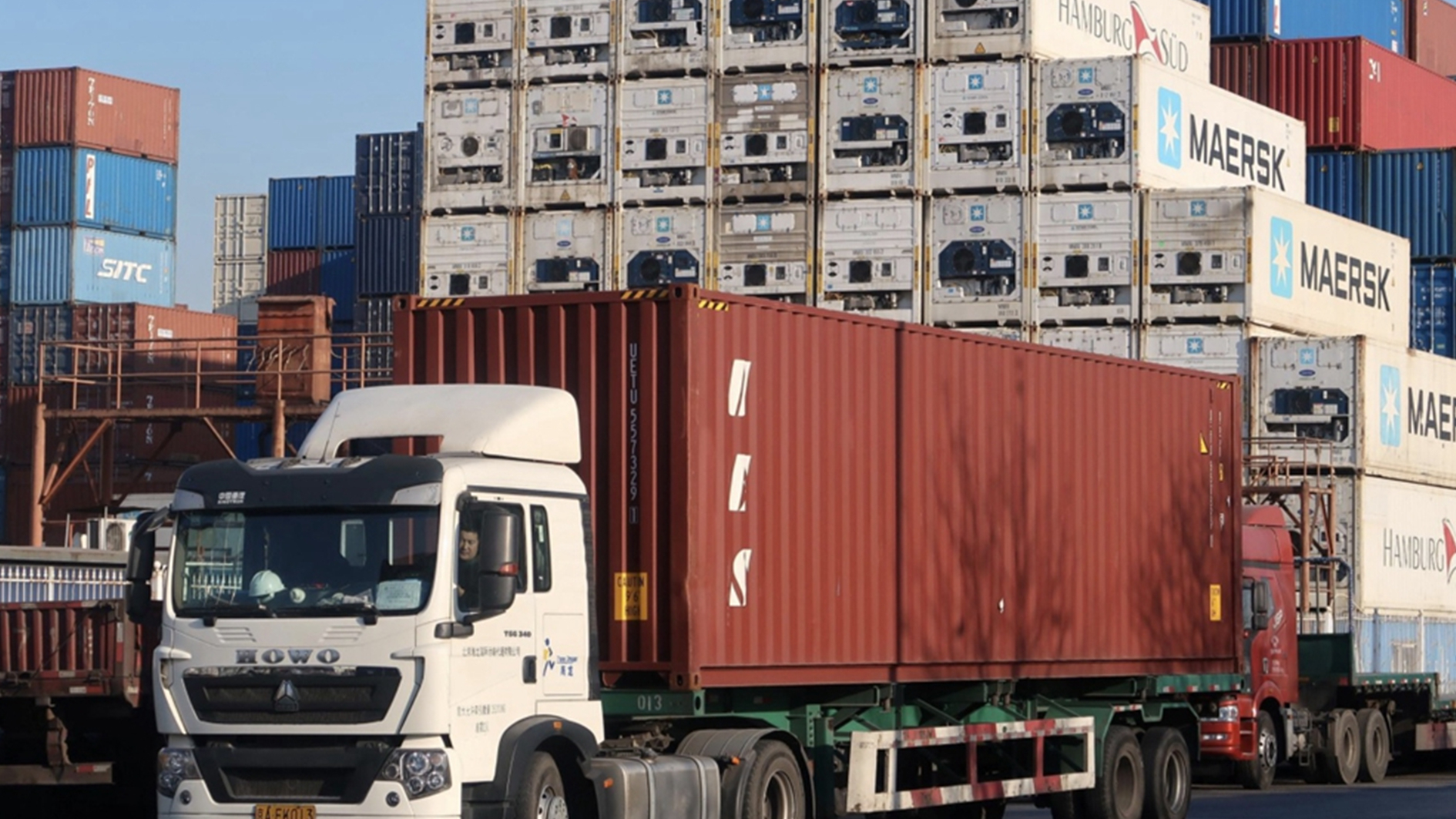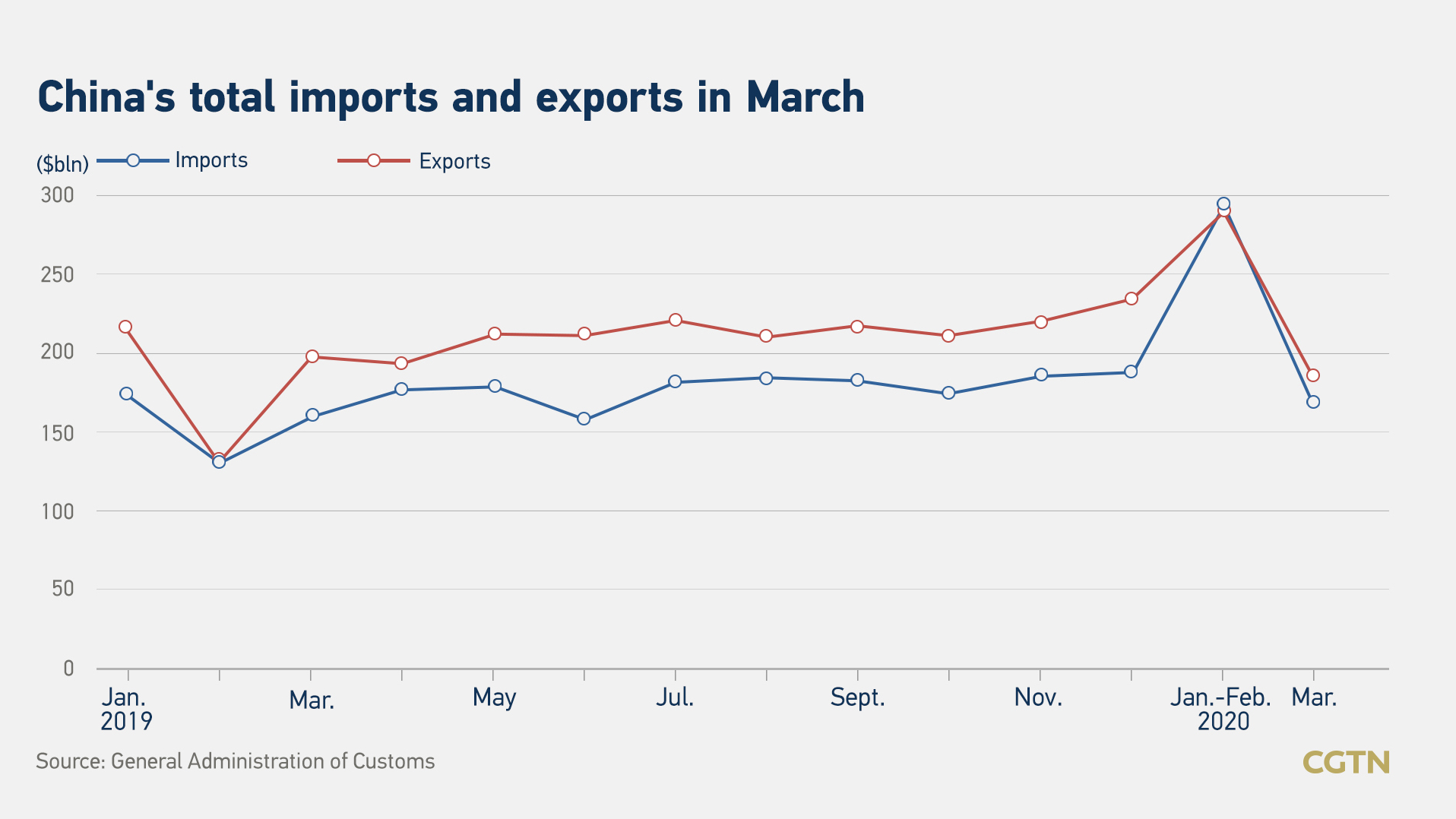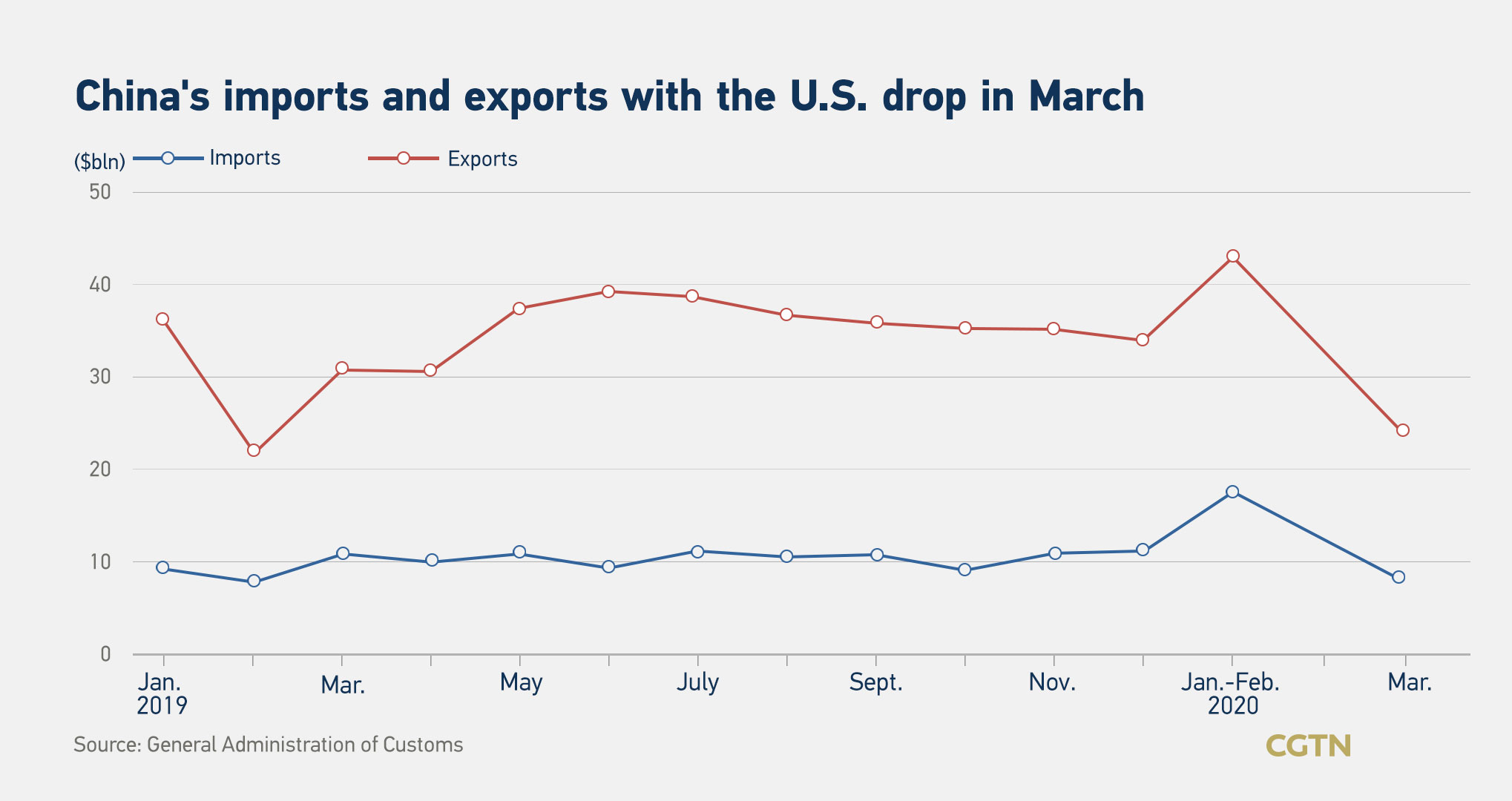02:14

China's exports dropped by 6.6 percent year on year to 185.2 billion U.S. dollars, and imports edged down 0.9 percent to 165.3 billion U.S. dollars in March, showing signs of recovery and beating forecast, data from China's General Administration of Customs showed on Tuesday.
A Reuters poll earlier estimated exports to fall by 14 percent in March, and imports to drop 9.5 percent year on year, while Bloomberg forecast that both exports and imports would slump 10 percent or more.
The Trade surplus was 19.9 billion U.S. dollars in March, as compared with the 18.55 billion U.S. dollars predicted by economists polled by Reuters.

In March, China's imports and exports with ASEAN amounted to 56.9 billion U.S. dollars, accounting for 15.1 percent of the country's total foreign trade. ASEAN has thus become China's largest trading partner, while foreign trade with the EU amounted to 45.6 billion U.S. dollars.
China's trade with Belt and Road countries is another bright spot. "Although China's foreign trade declined in the first quarter, China's imports and exports with the Belt and Road countries maintained growth. It has become a stabilizer in China's foreign trade. Customs data shows China's foreign trade with Belt and Road countries reached 2.07 trillion yuan, rising 3.2 percent year on year," said said Li Kuiwen, director of the customs authority's statistics and analysis department.
The customs official warned that global trade will face a downturn this year due to the spread of the pandemic and shrinking external demand that will inevitably impact China's foreign trade sector. The difficulties faced by China's foreign trade this year should not be underestimated, added Li, noting that governments at all levels will also roll out measures to stabilize trade to minimize the negative impact of the pandemic.
In the first quarter of this year, China's foreign trade dropped by 8.4 percent year on year to 943.2 billion U.S. dollars under the influence of COVID-19 disruptions, said the country's customs authority.
In addition, modest declines were registered in private enterprises' imports and exports as their contribution to total foreign trade is on the rise. In the January-March period, private enterprises' foreign trade fell slightly by 2 percent, 4.4 percentage points less than the overall decline and signifying a stronger capability to resist risks, said Li. Among them, the imports and exports of private enterprises notched up a 6.5 percent gain in March, serving as the main force driving the improvement of foreign trade performance.
A backlog of orders cleared
The ease of slowdown in March can be mainly attributed to rapid resumption of work and production as the coronavirus has been basically contained domestically.
"A backlog of orders hoarded in the two months has a chance to be completed in March with the containment of the coronavirus and relative supportive policies," Bai Ming, deputy director of the international market research institute at the Chinese Academy of International Trade and Economic Cooperation under the Ministry of Commerce, told CGTN.
In January, the pandemic's impact was relatively mild coupled with the factor of the Spring Festival. But the resumption of work and production encountered difficulties in February when the pandemic got serious in China, which affected the foreign trade in that period, so lots of orders could not be finished. But with the resumption going forward, more workers can go back to the production line, so the orders delayed before were completed last month, Bai explained.
Also, domestic demand pushed imports to perform better with the gradual recovery of domestic industrial production. China's imports of consumer goods increased by 13 percent in the first quarter, driven by the growth in meat and sugar imports. Imports of raw materials like coal, crude oil, metal ores, and integrated circuits also ascended by 23.8 percent, 8.3 percent, 6.8 percent and 13.1 percent, respectively.
Meanwhile, China exported a large amount of medical supplies of good quality in March, including face masks and ventilators, contributing to the fight against COVID-19. From March 1 to April 5, China exported 10 billion yuan worth of medical supplies.

China-U.S. phase one trade deal gradually implemented
Some positive factors are building up in China-U.S. trade with the gradual implementation of the phase one trade deal, evidenced in particular by the sound growth momentum in commodities imported from the U.S., said Li.
In the first quarter of this year, the total volume of China-U.S. trade settled at 95.7 billion U.S. dollars, down 20.1 percent year on year, of which exports to the U.S. went down by 25.2 percent to stand at 68.3 billion U.S. dollars and imports edged down 3.7 percent to reach 27.4 billion U.S. dollars.
In the first quarter, imports of agricultural products such as soybeans, pork and cotton from the U.S. have grown rapidly, with the total trade volume skyrocketing 110 percent to the tune of 35.56 billion yuan, of which 7.8 million tons are soybeans and 168,000 tons are pork, surging 210 percent and 640 percent, respectively.
The drop in China-U.S trade volume is partly affected by the pandemic as imports of agricultural products will face stricter inspection and quarantine measures due to hygiene concerns, Liu Chunsheng, an associate professor at the Central University of Finance and Economics and the deputy dean of Blue Source Capital Research Institute, told CGTN.
Also, with the spread of the pandemic in the United States and accompanied restrictions, production has stalled in the U.S., so supply cannot be guaranteed, which is similar to the situation in China from January to February when the pandemic broke out, said Liu.

A staff member speaks into an intercom at Yangluo Port in Wuhan, central China's Hubei Province, April 12, 2020. /Xinhua
A staff member speaks into an intercom at Yangluo Port in Wuhan, central China's Hubei Province, April 12, 2020. /Xinhua
Coronavirus spread could lead to a tough Q2
Trade is affected by the development of the pandemic. Experts say the fast spread of the coronavirus overseas, especially in traditional markets like the U.S. and Europe, could take a toll on China's foreign trade in the second quarter.
"Some orders from overseas companies are reduced or canceled because of the deterioration of the coronavirus, which has affected the international industrial chains," said Bai.
"Due to the lag effect, March's data may not fully reflect the impact of the pandemic on trade with the U.S. and Europe, which are the hardest-hit areas,"John Gong, a research follow at Charhar Institute and professor at the University of International Business and Economics, told CGTN.
In the second quarter, trade with the U.S. and the EU could be worse as the pandemic is still fast spreading, Gong added.
Experts also say the second half of the year will see more positive signs in China's foreign trade when the pandemic could gradually be eased, and China, the largest manufacturer, will still be the major supplier of goods for the world.
"In the second half of the year, the situation of foreign trade would turn for the better as needs of daily necessities would come back to China," said Bai.
(CGTN's Guan Xin also contributed to the story.)
(Cover image: A truck carrying a container at a logistics center near the port in Tianjin, China, December 12, 2019. /Reuters)